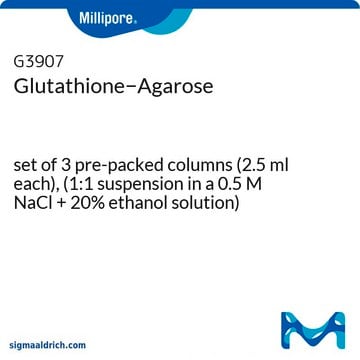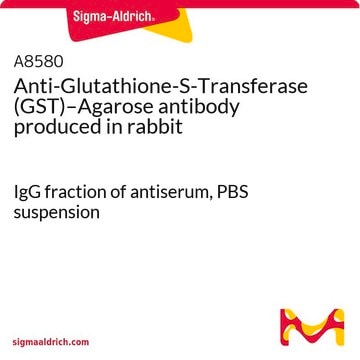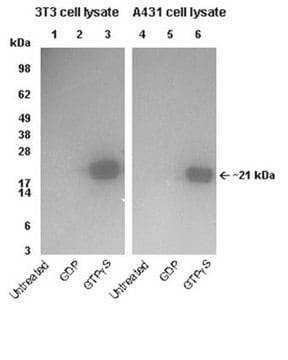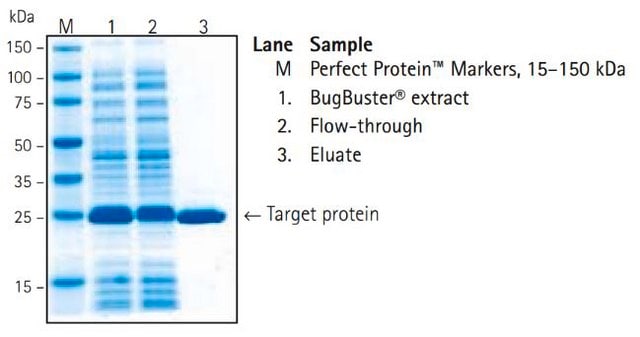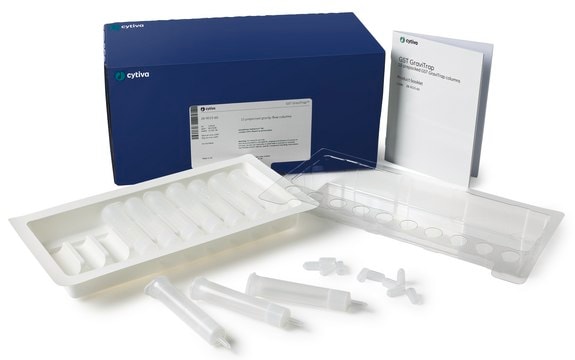Transportation information can be found in Section 14 of the product's (M)SDS.To access the shipping information for this material, use the link on the product detail page for the product.
Wichtige Dokumente
G4510
Glutathion−-Agarose
lyophilized powder
Synonym(e):
Glutathion-Agarose-Harz, GSH-Agarose, S-verknüpfte Glutathion-Agarose
Größe auswählen
Größe auswählen
About This Item
Empfohlene Produkte
Form
lyophilized powder
Qualitätsniveau
chemische Klasse(n) des Analyten
proteins (GST)
Kennzeichnungsgrad
≥10 μmol per mL gel
Methode(n)
immunoprecipitation (IP): suitable
protein purification: suitable
Matrix
4% cross-linked beaded agarose
Matrixaktivierung
epoxy
Matrixanbindung
sulfur
Matrix-Spacer
12 atoms (10 carbon)
Lagertemp.
−20°C
Suchen Sie nach ähnlichen Produkten? Aufrufen Leitfaden zum Produktvergleich
Allgemeine Beschreibung
Anwendung
- zur Aufreinigung des mit Glutathion-S-Transferase (GST) fusionierten Proteins zur Erzeugung des polyklonalen Antikörpers M4P
- zur Inkubation der Überstandfraktionen zur Aufreinigung von p53 voller Länge (AS 1–393) und seiner DNA-bindenden Domäne (AS 94–288)
- bei der Affinitätsreinigung des Fusionsproteins
Biochem./physiol. Wirkung
Leistungsmerkmale und Vorteile
- Ermöglicht eine schnelle, milde, nicht denaturierende und hochselektive Aufreinigung von Glutathion-bindenden Enzymen.
- Hat bei ordnungsgemäßer getrockneter Lagerung bei -20 °C eine Haltbarkeit von zwei Jahren
- Bindungskapazität: 5–10 mg Glutathion-S-Transferase pro ml Harz
Menge
Physikalische Form
Lagerklassenschlüssel
11 - Combustible Solids
WGK
WGK 3
Flammpunkt (°F)
Not applicable
Flammpunkt (°C)
Not applicable
Persönliche Schutzausrüstung
Eyeshields, Gloves, type N95 (US)
Hier finden Sie alle aktuellen Versionen:
Analysenzertifikate (COA)
Die passende Version wird nicht angezeigt?
Wenn Sie eine bestimmte Version benötigen, können Sie anhand der Lot- oder Chargennummer nach einem spezifischen Zertifikat suchen.
Besitzen Sie dieses Produkt bereits?
In der Dokumentenbibliothek finden Sie die Dokumentation zu den Produkten, die Sie kürzlich erworben haben.
Kunden haben sich ebenfalls angesehen
Verwandter Inhalt
Investigate in vitro protein-protein interactions with pull-down assays, utilizing affinity, GST pull-down, TAP, and co-immunoprecipitation methods.
Untersuchen Sie Protein-Protein-Interaktionen im Reagenzglas mithilfe von Pulldown-Assays, bei denen Methoden wie Affinität, GST-Pulldown, TAP und Co-Immunpräzipitation zum Einsatz kommen.
-
What is the Department of Transportation shipping information for this product?
1 answer-
Helpful?
-
-
When using Product G4510, Glutathione-Agarose, how do I store the swollen resin?
1 answer-
After the resin has been swollen, it can be stored in 2 M NaCl at 2 to 8 °C. For long-term storage, a bacteriostatic agent such as 1 mM sodium azide or 0.02% thimerosal should be included. Alternatively, the resin can be relyophilized after addition of lactose.
Helpful?
-
-
How much Product G4510, Glutathione-Agarose, do I receive and how do I swell my powder?
1 answer-
This material is sold by the final volume of gel produced after swelling of the powder. One gram of powder swells to approximately 14 mL of gel. (Approximately 70 mg of powder swells to 1 mL of gel.) Swell the lyophilized powder in deionized water (use of some buffers can result in non-recoverable loss of volume) at 200 mL/g. Typically 90 to 95% of swelling occurs within 30 minutes at room temperature, but it may require overnight at 2 to 8 °C for 100% swelling to occur. After swelling, the agarose beads must be washed thoroughly with 10 volumes of water or equilibration buffer (such as PBS) to remove the lactose present in the lyophilized product.
Helpful?
-
-
How is Product G4510, Glutathione-Agarose, resin conjugated to the glutathione, and what is the binding capacity of the resin?
1 answer-
This product consists of glutathione attached through the sulfur to epoxy activated 4% cross-linked beaded agarose, resulting in a 12 atom spacer. Binding capacity: approx. 5 to 10 mg glutathione S-transferase per mL resin.
Helpful?
-
-
What reagents are compatible with Product G4510, Glutathione-Agarose, resin?
1 answer-
Tris or phosphate buffers (pH 6.5 to 9.5) are typical lysis buffers compatible with glutathione affinity chromatography. Salt concentrations of up to 1 Molar do not interfere with binding. Protease inhibitors such as EDTA (Product No. E7889) or PMSF (Product No. P7626) are often included in the lysis buffer. Serine protease inhibitors included in the lysis buffer will not interfere with subsequent thrombin or factor Xa treatment as these inhibitors are removed before the proteolysis step. The binding of GST to glutathione-agarose is unaffected by 1% Triton X-100, 1% Tween-20, 1% CTAB, 10 mM DTT or 0.03% SDS.
Helpful?
-
-
How do I regenerate Product G4510, Glutathione-Agarose, resin?
1 answer-
Regeneration method:1. Wash with approximately 5 resin volumes of 0.1 M borate buffer, pH 8.5 containing 0.5 M NaCl (Cleansing Buffer 1).2. Wash with at least 5 column volumes of deionized water.3. Wash with at least 5 column volumes of 0.1 M acetate buffer, pH 4.5, containing 0.5 M NaCl (Cleansing Buffer 2).4. Wash with approximately 5 resin volumes of deionized water. For long-term storage, store in 2 M NaCl containing a bacteriostatic agent.5. Equilibrate with equilibration buffer before use.
Helpful?
-
Active Filters
Unser Team von Wissenschaftlern verfügt über Erfahrung in allen Forschungsbereichen einschließlich Life Science, Materialwissenschaften, chemischer Synthese, Chromatographie, Analytik und vielen mehr..
Setzen Sie sich mit dem technischen Dienst in Verbindung.



